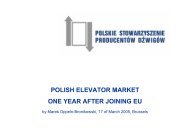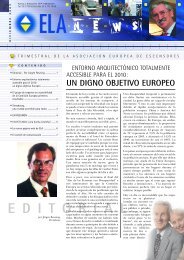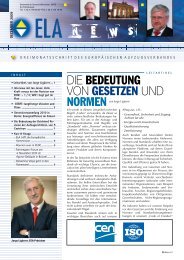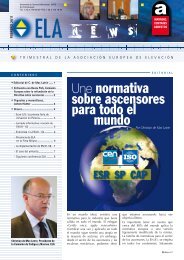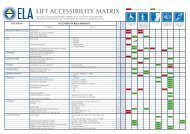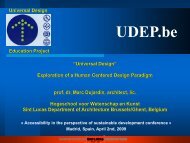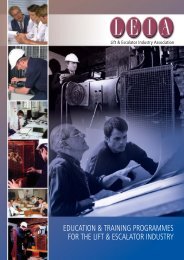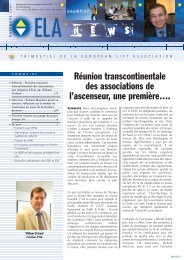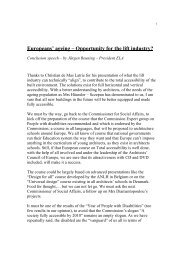WP6-Brochure-E4 brochure - ELA European Lift Association.
WP6-Brochure-E4 brochure - ELA European Lift Association.
WP6-Brochure-E4 brochure - ELA European Lift Association.
You also want an ePaper? Increase the reach of your titles
YUMPU automatically turns print PDFs into web optimized ePapers that Google loves.
Raising awareness<br />
Setting a standard for measuring energy consumption, calculation of the energy demand and<br />
complementary legislation would already contribute to raise awareness about energy<br />
efficiency to some extent. However, higher levels of awareness are necessary – especially on<br />
the customer’s side – to guarantee that energy efficiency of lifts is optimised. Although<br />
developing a communication strategy for an awareness campaign is beyond the scope of this<br />
report, some advice will be given regarding target groups and options to be considered.<br />
Main target groups for awareness‐raising measures are the stakeholders involved in the<br />
planning and construction of buildings, i.e. those who decide if new equipment is installed, as<br />
well as those who later use or operate an installation, i.e. those paying for energy consumption<br />
and deciding on retrofits. As it was already discussed above, this includes several groups of<br />
stakeholders.<br />
One way of raising awareness in several target groups is labelling equipment in a comparable<br />
and comprehensive way, as has been done for other electrical equipment, e.g. freezers and<br />
refrigerators. However, given the high number of types of lifts, the development of a<br />
comprehensive labelling system may take some time. VDI 4707 provides a labelling example. In<br />
the meantime, other measures to raise awareness should be put in practice. This is also<br />
important as labelling addresses only new equipment and does not include existing<br />
installations. However, due to the long life‐time of lifts, it is necessary that measures for<br />
market transformation address existing installations as well.<br />
The first steps to raise awareness are already part of the <strong>E4</strong> project, e.g. developing<br />
dissemination material providing information for different kinds of target groups and<br />
organising workshops with information on this topic. These activities need to be extended<br />
after the end of the project, e.g. by national energy agencies or notified bodies. Main target<br />
groups should be architects and construction engineers, construction companies that act as<br />
general contractors, as well as building operators, and administrators. While the first two<br />
groups are more important in the process of installing new equipment, the last one is relevant<br />
in case of retrofits and modernisation. However, in order to advise all these groups on energyefficient<br />
equipment, easily accessible and comprehensive information material is required – a<br />
topic that will be further discussed in the next section.<br />
Enhancing knowledge<br />
One of the general experiences of lift experts is that most customers have little knowledge of<br />
lifts. Furthermore, specialised consultants are only involved in a minority of projects. Thus,<br />
raising awareness is not enough to enhance energy efficiency: even if decision‐makers were<br />
aware of energy efficiency, they would not know how to achieve this goal. Here again,<br />
standardised measurement turns out to be the key to energy efficiency. Without comparable<br />
data for different models and types of lifts, customers are not in a position to make an<br />
informed decision.<br />
101



